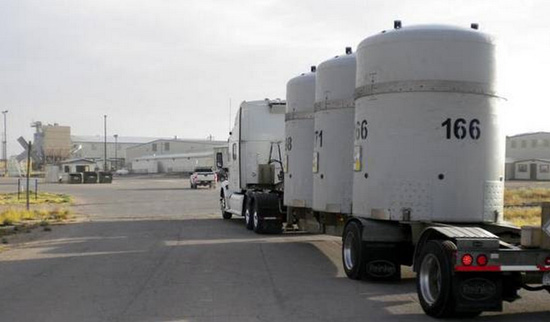Stealthily loading West Texas up with radioactive waste
18 June 2014
Dallas Morning News Editorial

U.S. Department of Energy
Waste Control Specialists is in talks to start receiving depleted uranium, and it wants to triple its West Texas site’s size.
The nuclear waste disposal site operated by Waste Control Specialists in West Texas is steadily morphing away from its original mission as a depository for very limited quantities of low-level radioactive items from Texas and Vermont. Today, the site is taking on much greater quantities and higher levels of radioactive waste from multiple states, and its owner wants permission to dramatically expand operations.
If this mission creep continues, Texans could find themselves the unwitting hosts of the nation’s first permanent for-profit high-level nuclear waste facility. If Waste Control’s intention is to build such a site, it owes Texans a straightforward, transparent declaration of these plans so a full public debate can occur.
This nation plunged headlong into nuclear research in the 1940s, followed in subsequent decades by production of thousands of nuclear warheads, construction of nuclear reactors and other radioactive devices used in hospitals and manufacturing. Throughout, everyone involved has confronted a nagging question: Where will all this radioactive waste be permanently stored?
No state wants such a sensitive and dangerous site. What region isn’t vulnerable to earthquakes, floods, fires or other potentially catastrophic events? With the inventory of waste continuing to rise, the only option has been to store it in temporary facilities around the country. That’s not a solution.
This waste has to go somewhere. If Waste Control’s facility northwest of Midland-Odessa is the nation’s best answer, then let’s have that discussion. Waste Control’s appearance of stealthily imposing a bigger footprint is cause for public skepticism.
When Waste Control sought a license in 2007, three members of the Texas Commission on Environmental Quality resigned rather than be party to it. The site sits atop the Ogallala Aquifer, and any radiation leak could risk contaminating a major water source for eight states. Waste Control maintains that the facility is state of the art, with multiple backup measures to avert accidents.
In April, Waste Control contracted with the U.S. Energy Department to store hundreds of truckloads of waste from nearly seven decades of nuclear research at New Mexico’s Los Alamos National Laboratory, where the world’s first atomic bomb was developed. Some of the waste comes from a temporary storage facility in Carlsbad, N.M., where radioactive leaks occurred in February.
What once was a two-state pact to house low-level waste now involves dozens of states. Waste Control is in talks to start receiving higher-level waste, including depleted uranium, at the same time it wants to triple the site’s size. Yet it wants to reduce the amount of money it is required to keep available if a disaster leads to large-scale liability claims.
Texans deserve to be part of this important discussion. But they can’t participate if they don’t even know it’s happening.
This document contains copyrighted material whose use has not been specifically authorized by the copyright owner. SEED Coalition is making this article available in our efforts to advance understanding of ecological sustainability, human rights, economic democracy and social justice issues. We believe that this constitutes a "fair use" of the copyrighted material as provided for in section 107 of the US Copyright Law. If you wish to use this copyrighted material for purposes of your own that go beyond "fair use", you must obtain permission from the copyright owner.


